Are you looking to build a personal brand that stands out in the digital world? Want to create a website that showcases your expertise and captures the attention of potential customers? Look no further! In this comprehensive guide, we will explore the best practices and strategies for creating outstanding personal brand websites that leave a lasting impression.
Why Personal Brand Websites Matter
In today’s hyper-connected world, having a strong personal brand is essential for professional success. A personal brand website serves as your digital identity, allowing you to showcase your skills, experience, and unique personality. It is a platform where you can tell your story, connect with your audience, and establish yourself as an authority in your industry.
The Power of a Personal Brand Website
A personal brand website offers several distinct advantages over traditional resumes and cover letters. While these documents provide a snapshot of your professional background, they often fail to capture your true essence and personality. In contrast, a personal brand website allows you to:
- Highlight Your Unique Value Proposition: Your website provides an opportunity to differentiate yourself from the competition. You can showcase your skills, expertise, and achievements in a visually appealing and engaging format.
- Tell Your Story: A personal brand website allows you to share your journey and experiences, giving your audience a deeper understanding of who you are and what you stand for.
- Build Trust and Credibility: By presenting yourself professionally and consistently across all aspects of your website, you can establish trust and credibility with your audience.
- Control Your Online Reputation: With a personal brand website, you have control over the content and narrative surrounding your personal brand. You can shape how you are perceived online and ensure that accurate and positive information is readily available.
- Enhance Discoverability: By optimizing your website for search engines, you can increase your visibility and attract more opportunities. A well-optimized personal brand website can rank highly in search engine results, making it easier for potential clients or employers to find you.
Key Elements of an Effective Personal Brand Website
Building a successful personal brand website requires careful planning and consideration. Here are some key elements that should be incorporated into your website to ensure its effectiveness:
1. Clear Brand Messaging
Before diving into the design and layout of your website, it is crucial to define your brand messaging. What is your unique value proposition? What sets you apart from the competition? Clearly communicate your message, purpose, and mission throughout your website to captivate your audience and leave a lasting impression.
2. Engaging Visual Design
The visual design of your website plays a significant role in capturing the attention of your visitors. Choose a design that aligns with your brand identity and reflects your industry. Utilize high-quality images, videos, and graphics to create an immersive and visually appealing experience. Remember to keep the design clean, uncluttered, and mobile-friendly for optimal user experience.
3. Compelling About Page
Your About page is one of the most important sections of your personal brand website. This is where you have the opportunity to introduce yourself, share your story, and establish a personal connection with your audience. Be authentic, transparent, and relatable, and highlight your expertise and accomplishments.
4. Showcase Your Work and Achievements
One of the primary purposes of a personal brand website is to showcase your work and achievements. Create a portfolio or gallery section where you can display your best projects, case studies, or testimonials. This provides tangible proof of your skills and expertise and helps build trust with potential clients or employers.
5. Blog or Content Hub
A blog or content hub is an excellent way to demonstrate your knowledge, expertise, and thought leadership. Regularly publishing high-quality, informative, and engaging content can attract a loyal following and position you as an authority in your field. Incorporate a blog into your personal brand website and develop a content strategy to consistently create valuable content for your audience.
6. Contact Information and Call-to-Action
Make it easy for visitors to get in touch with you by including clear and prominent contact information on your website. Provide multiple channels for communication, such as email, phone, and social media links. Additionally, include a compelling call-to-action to encourage visitors to take the next step, such as scheduling a consultation or signing up for your newsletter.
7. Optimize for Search Engines
To ensure that your personal brand website is discoverable, it is essential to optimize it for search engines. Conduct keyword research to identify relevant keywords and incorporate them naturally throughout your website’s content. Pay attention to on-page SEO elements such as meta tags, headings, and alt tags for images. Additionally, consider implementing a content marketing strategy to attract organic traffic and improve your website’s search engine rankings.
8. Mobile-Friendly Design
With the increasing use of mobile devices, it is crucial to ensure that your personal brand website is optimized for mobile viewing. Responsive design allows your website to adapt seamlessly to different screen sizes and resolutions, providing a consistent and user-friendly experience for visitors accessing your site from smartphones or tablets.
Examples of Exceptional Personal Brand Websites
To inspire you in creating your personal brand website, let’s explore some exceptional examples from industry leaders:
1. Tony Robbins
Tony Robbins, the renowned life and business strategist, has a personal brand website that reflects his authority and expertise. His website incorporates captivating visuals, compelling copy, and easy navigation. Visitors can explore his vast array of resources, including blog posts, courses, and event information.
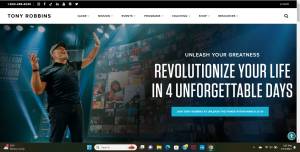
Industry: Self Help, Business, Finance
Website: Tony Robbins
Instagram: Tony Robbins
Facebook: Tony Robbins
2. Gary Vaynerchuk

Gary Vaynerchuk, a pioneer in personal branding, has a website that showcases his expertise in new media, marketing, and entrepreneurship. His website features a clean and modern design, with easy access to his blog, videos, and social media channels. Visitors can also explore his books and speaking engagements.
Industry: New Media, Marketing, Entrepreneurship
Website: Gary Vaynerchuk
Instagram: Gary Vaynerchuk
Facebook: Gary Vaynerchuk
3. Marie Forleo
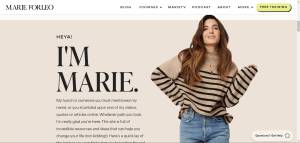
Marie Forleo, an inspiring female power-figure, has a personal brand website that highlights her authenticity and passion for helping others. Her website features a vibrant design, engaging copy, and a wealth of resources for entrepreneurs. Visitors can access her blog, online courses, and free training videos.
Industry: Entrepreneurship, Self-Help, Marketing
Website: Marie Forleo
Instagram: Marie Forleo
Facebook: Marie Forleo
4. Nicholas Kusmich
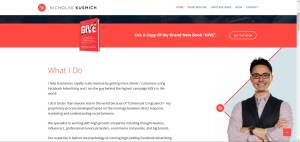
Nicholas Kusmich, a Facebook ads expert, has a personal brand website that showcases his expertise in digital marketing. His website features a sleek and professional design, with a focus on his proprietary processes and strategies. Visitors can access his blog, online courses, and consulting services.
Industry: Digital Marketing
Website: Nicholas Kusmich
Facebook: Nicholas Kusmich
5. Mel Abraham
Mel Abraham, an entrepreneurial thought leader, has a personal brand website that emphasizes community and business strategies. His website features a clean and organized design, with easy access to his blog, podcast, and online courses. Visitors can explore his frameworks and methodologies for creating a successful business.
Industry: Entrepreneurship, Marketing
Website: Mel Abraham
Instagram: Mel Abraham
Twitter: Mel Abraham
6. J.J. Virgin
J.J. Virgin, a celebrity nutrition and fitness expert, has a personal brand website that showcases her expertise in health, wellness, and nutrition. Her website features a visually appealing design, with easy access to her blog, podcast, and online programs. Visitors can learn about her holistic approach to health and access valuable resources.
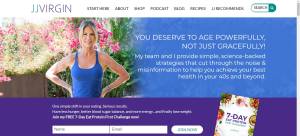
Industry: Health, Wellness, Nutrition, Fitness
Website: J.J. V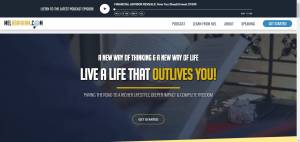 irgin
irgin
Facebook: J.J. Virgin
Instagram: J.J. Virgin
Common Personal Branding Mistakes
Deepening your understanding of these common pitfalls can dramatically improve the strength and clarity of your personal brand.
1. Lack of Consistency Across Platforms
Consistency is not just about using the same profile picture across LinkedIn, Twitter, and Instagram. It extends to maintaining a uniform tone of voice, style of communication, and visual elements such as colors and fonts. For instance, if you are a professional consultant, ensure your LinkedIn showcases a professional image and detailed descriptions of your work, aligning with a more approachable but still professional tone on Twitter or Instagram. This uniformity helps in reinforcing your identity and makes you easily recognizable to your audience.
2. Neglecting Your Unique Value Proposition (UVP)
Identify what sets you apart from others in your field. It could be your unique approach to solving industry-specific problems, a blend of skills not commonly found together, or your personal journey and how it influences your work. For example, if you have a background in both technology and psychology, highlight how this combination provides a unique perspective in your projects or services. Clearly articulate this UVP on your website’s homepage, in your social media bios, and within networking conversations.
3. Overlooking the Importance of Storytelling
Integrate storytelling into your branding by sharing personal anecdotes that align with your professional image. For example, if resilience is a key part of your brand, share stories of overcoming challenges, whether in blog posts, video content, or podcast interviews. These stories should highlight not just the struggle, but also the strategies you used to overcome obstacles, providing value and insight to your audience.
4. Ignoring Your Target Audience
Create detailed audience personas based on your ideal clients or followers. What are their challenges, goals, and interests? Tailor your content to address these aspects. For example, if your target audience consists of small business owners, create content that addresses common pain points like budgeting, marketing, and time management. Use language and examples that resonate with their experiences and industry.
5. Avoiding Self-Promotion
Develop a strategy for self-promotion that feels authentic and comfortable. This could include sharing testimonials from satisfied clients, highlighting milestones or awards, or posting case studies that demonstrate your successes. Frame these achievements in a way that shows gratitude or focuses on the team effort involved, which can help in mitigating feelings of boastfulness.
6. Failing to Engage with Your Audience
Set aside time each day or week to respond to comments, messages, and emails. Join discussions on LinkedIn or Twitter that are relevant to your industry. Ask open-ended questions in your posts to encourage dialogue, and when someone takes the time to engage, respond thoughtfully to keep the conversation going.
7. Neglecting Professional Development
Commit to ongoing learning and share this journey with your audience. This could involve taking a new course and sharing key learnings, attending a conference and posting updates, or reading a book and offering a review. This not only keeps your brand fresh but also demonstrates your commitment to growth and excellence.
8. Poor Online Presence Management
Schedule monthly audits of your online presence. Update your LinkedIn profile with any new accomplishments or roles, remove or update old or irrelevant content from your website, and ensure your social media feeds reflect your current brand and professional standards. Use tools like Google Alerts to monitor mentions of your name or brand online.
9. Not Leveraging Networking Opportunities
Identify key events, forums, or groups where you can connect with others in your industry. Set goals for networking, such as making a certain number of new connections each month or attending a specific number of events per quarter. Follow up with new contacts with a personalized message or offer to meet for coffee or a virtual chat.
10. Forgetting to Measure Success
Define specific, measurable goals for your personal brand. This could include metrics such as website traffic, follower growth, engagement rates, or the number of new business inquiries. Use tools and platforms analytics to track these metrics. Regularly review your performance and adjust your strategies accordingly to ensure continuous improvement and alignment with your branding objectives.
By addressing each of these areas with specific actions and regular reflection, you can avoid common pitfalls and strengthen your personal brand, making it more resonant and effective in achieving your professional goals.
The Role of Content in Personal Branding
Content is the cornerstone of personal branding; it communicates your voice, values, and expertise to the world. Understanding and leveraging the power of content can significantly enhance your personal brand’s reach and impact.
Showcasing Expertise Through Valuable Content
Create content that showcases your knowledge and expertise in your field. This could be blog posts that solve common problems in your industry, video tutorials that offer step-by-step guides, or infographics that break down complex information into digestible pieces. For example, if you’re a marketing expert, you could write articles about the latest trends in digital marketing or tips for creating effective social media strategies. Consistently providing valuable content positions you as an authority in your field and builds trust with your audience.
Utilizing Various Content Formats
Diversify your content by utilizing different formats to cater to varying audience preferences and platforms. This includes long-form articles, short blog posts, videos, podcasts, webinars, and social media posts. Each format has its strengths and caters to different segments of your audience. For instance, while a detailed guide might work well as a blog post, quick tips could be shared as short videos or graphics on Instagram or Twitter. Experimenting with various formats also helps in determining what resonates best with your audience.
Personal Storytelling and Relatability
Incorporate personal stories and experiences into your content to make it more relatable and engaging. Sharing your challenges, successes, and lessons learned adds a human element to your brand and helps in forming deeper connections with your audience. Ensure these stories align with your professional image and reinforce your brand’s values. For example, sharing your journey from a junior employee to an industry leader can inspire and motivate your audience, while also highlighting your growth and expertise.
Consistency and Content Calendar
Maintain a consistent content creation and posting schedule. Consistency helps in keeping your audience engaged and reinforces your brand presence. Develop a content calendar to plan your topics, formats, and posting schedule. This keeps your content strategy organized and ensures a steady stream of content. Remember, consistency doesn’t necessarily mean posting daily; it’s about setting a realistic schedule that you can maintain over time.
Engaging and Interacting with Your Audience
Content is not just about dissemination; it’s also about engagement. Encourage your audience to interact with your content through comments, shares, and discussions. Ask questions, solicit feedback, and respond to comments to foster a sense of community. Engagement not only boosts your content’s reach but also provides valuable insights into your audience’s preferences and needs.
Leveraging SEO for Greater Visibility
Optimize your content for search engines to enhance its visibility and reach. Use relevant keywords, meta descriptions, and tags to improve your content’s search engine rankings. However, ensure your content remains engaging and valuable to your audience. SEO should enhance your content, not compromise its quality. For instance, if you specialize in financial planning, include relevant keywords such as “retirement planning tips” or “budgeting strategies” naturally within your content.
Measuring and Analyzing Content Performance
Track and analyze your content’s performance to understand what works and what doesn’t. Use analytics tools to monitor engagement rates, traffic sources, and audience behavior. This data allows you to refine your content strategy, focus on what’s effective, and continually improve your content’s impact. For example, if your video content receives higher engagement compared to text posts, consider increasing video production.
By embracing the pivotal role of content in personal branding, you can effectively communicate your expertise, engage with your audience, and build a strong, credible brand. Remember, content is not just about what you say; it’s about what value you provide. Make each piece of content count towards building a cohesive, impactful personal brand.
Conclusion
In today’s digital landscape, a compelling personal brand website is crucial for establishing your online presence and attracting opportunities. By incorporating the key elements discussed in this guide and drawing inspiration from the exceptional examples provided, you can create a personal brand website that sets you apart from the competition and helps you achieve your professional goals. Remember, your personal brand website is a reflection of your unique identity and expertise, so be authentic, engaging, and consistent in your messaging. Start building your personal brand website today and take your online presence to new heights!
FAQ: Building and Managing Your Personal Brand
What is a personal brand website?
A personal brand website is a dedicated space online where you can showcase your work, achievements, and professional identity. It acts as a central hub for your personal branding efforts, providing visitors with information about who you are, what you offer, and how you can add value to their lives or businesses.
Which platform is best for personal branding?
The best platform for personal branding depends on your industry, audience, and goals. LinkedIn is excellent for professional networking and content sharing, while Instagram works well for visual storytelling and brand building. Twitter is great for engaging in industry conversations, and a personal blog or website offers complete control over your brand narrative.
How do I create a personal brand online?
Creating a personal brand online involves defining your unique value proposition, identifying your target audience, and consistently communicating your message across various online platforms. Share valuable content, engage with your audience, and showcase your expertise to build credibility and visibility.
How can I find my personal brand?
Finding your personal brand involves introspection and self-discovery. Identify your strengths, passions, and values. Consider how others perceive you and what makes you different from your peers. Aligning these elements with the needs of your target audience will help you carve out your unique personal brand.
What are the 4 P’s of personal branding?
The 4 P’s of personal branding are:
- Presentation: How you showcase your skills, experiences, and personality.
- Positioning: How you differentiate yourself from others in your field.
- Promotion: How you market yourself to your target audience.
- Persistence: How consistently and effectively you communicate your brand over time.
Do I need a website for my personal brand?
While not strictly necessary, a website can be a powerful tool for your personal brand. It provides a platform that you fully control, allowing you to present a comprehensive and curated image of yourself. A website also helps in establishing credibility and can improve your visibility online.
What are examples of a personal brand?
Examples of personal brands include:
- Oprah Winfrey: Empowerment and self-improvement.
- Elon Musk: Innovation and risk-taking in technology.
- Gary Vaynerchuk: Entrepreneurship and social media expertise. These individuals have built strong personal brands that reflect their unique values, visions, and voices.
How do I rebrand myself?
Rebranding yourself involves reassessing your current brand, identifying the changes you want to make, and developing a new strategy to communicate those changes. Update your visual identity, refine your messaging, and align your online presence with your new brand direction. Consistently showcase your evolved brand across all platforms.
What are the 6 personal branding types?
The 6 personal branding types are:
- The Altruist: Focused on serving others and making a difference.
- The Careerist: Professional and career-focused, often sharing industry insights.
- The Hipster: Trendy, creative, and often early adopters of new ideas and technology.
- The Boomerang: Engages audiences by sparking debate and inviting feedback.
- The Connector: Builds and nurtures a wide network, connecting people with each other.
- The Selective: Shares selectively, focusing on deep, meaningful content rather than frequency.
Featured Image Credit: Photo by Christin Hume; Unsplash – Thank you!













